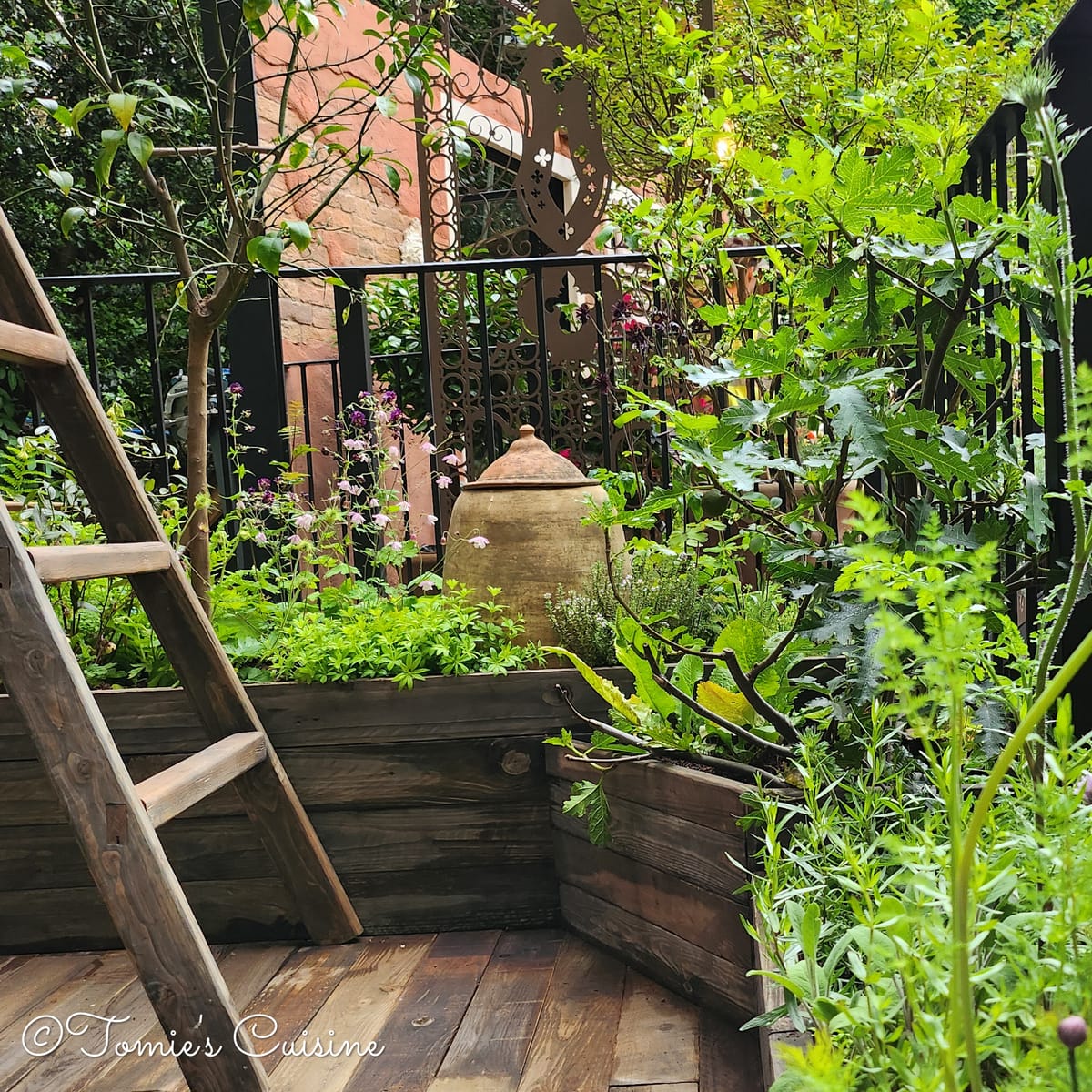We are live at the RHS Chelsea Flower Show! Come see us at the balcony garden at “Tomie’s Cuisine, the Nobonsai”!
We wanted to dedicate an article to the garden’s centrepiece, the composter, which enables minimising waste. We have used this for over two years, and our food waste bin has never been so suspiciously little – in the eyes of the bin collector, at least.
Alice Garden’s original compost

It has been over two years since Tsuyako (my mum) placed a compost bin in our garden. However, it’s not a compost bin made of plastic or a large compost heap; it’s a long terracotta plant pot. It’s perfect for us since our garden isn’t that big, but we can still get nutrients from the food waste to the soil. By using the terracotta pot, it’s breathable. Since then, almost all the food waste has gone into our compost bin, so we barely use the food waste bin or bag.
How does it work?
The terracotta compost bin sits atop a ~1m deep hole. If you are using a rhubarb forcer, simply leave it as is, but if you are using a plant pot like ours, you need to break the bottom. Then, put the lid on top. That’s it!
What we can/can’t put into the compost bin
We cannot put a few things in this compost bin.
Can: Most food waste—e.g., vegetable and fruit peels, meat, fish, etc.
Can’t: Bones (e.g. chicken or cattle), eggshells, very salty food.
We shouldn’t put bones or eggshells in the compost bin because they are tougher to break down, and the compost would quickly fill up.
One analogy I can think of is your stomach. You shouldn’t consume something difficult to digest every day. The same statement applies to the composter. In a way, this compost bin is also a brilliant way to know whether you are eating healthily!
Is there any other way to use the food that can’t go in the compost? I hear you ask. And I am glad you did.
We can’t reuse the bones, so they go into compostable food waste bin bags for local collection. However, we crush the eggshells and sprinkle them on the soil in the garden to prevent snails and slugs from eating the plants. We have a limited garden space, so if we find that we’ve got enough eggshells on the flower bed, then they’ll go with the bones in the food waste bin bag.
Is it smelly? Do we get lots of bugs? What about rats?

The food compost doesn’t smell, as the whole process happens under the soil. We live in a terraced house, and we’ve never received complaints from our neighbours. During the highs of summer, you may get a faint smell similar to a jar of pickles when you open it. Unlike the plastic compost bin, the terracotta pot allows some air to pass through, further reducing the smell.
There is a lid on top of the compost pot that prevents the flies from coming out. For example, when we opened it in summer during the day, many small flies came out because we scared them. But here’s a tip: if you open the lid at night or when it’s darker, they’ll be sleeping and won’t fly away. Those flies must be in the compost bin to break down the food waste and create nutrients in the soil, so don’t try to get rid of them.
A last note about the rats: the hole is deep enough and is closed with the terracotta pot, so they can’t get to the food.
One man’s trash is another man’s treasure: hello, nutrients!

A nutrient-rich soil
The bacteria in the soil will break down the waste, helping to feed the plants indirectly and avoiding the need for replanting or relying on any chemicals. After a while, you will see the mycorrhizal fungi spread across the soil as the plants feed from the composter (don’t break it!).
In a small space
You can view it by yourself at the RHS Chelsea Flower Show 2024 – blink and you’ll miss it – tucked away in the corner behind the plants. Our garden isn’t big either, so this terracotta compost bin is the perfect size.
You can put it wherever you want in your garden: In the corner, in a planter, behind a wall of flowers, or along the hedge like us. Just ensure you can easily access it even when it’s raining and your garden gets muddy (this spring was, unfortunately, a good example of how bad the weather can get).
Closing words

We hope this article was insightful and helped you get some ideas you can apply to your own garden or balcony. Our next article will be on the team Nobonsai lunches and the matching recipes to give you some great picnic ideas for this season!
In the meantime, follow us on our Instagram, Pinterest, and Facebook pages. Don’t forget to subscribe to our newsletter so you don’t miss our future blog posts about other recipes and eco-friendly tips.





